Table of Contents
- What is an email sequence?
- How long should an email sequence be?
- How to Create an Email Sequence
- Email Sequence Examples
- 7 Email Sequence Examples
- The Email Sequence That Made Us $100,000
- Email Sequence Best Practices
- From Theory to Practice: Implementing Your Email Strategy
What is an email sequence?
An email sequence is a set of automated emails that you send to prospects, users, or customers through automation software.
Specific actions or time-based conditions trigger each email in your sequence. Common sequences include welcome emails, onboarding sequences, and lead nurturing campaigns.
Why create an email sequence?
Email sequences combine automation and personalization, allowing you to scale meaningful relationships while optimizing time and resources. Here are four more reasons why you need to create an email sequence.
1. You can build stronger relationships with potential customers.
I’ve learned that strong customer relationships happen because you show up. Regular emails keep your brand front and center because people buy from brands they remember. But visibility alone won’t cut it.
You need trust. And trust comes from consistent, valuable communication.
Share useful content, tips, and resources tailored to their needs. When your audience sees you as a source of value, you’re no longer just another brand in their inbox.
2. You improve conversions and sales.
Sales don’t happen overnight. You have to warm up cold leads, turning skepticism into curiosity, then curiosity into action. Educational emails, case studies, and customer stories make your product feel real because nothing convinces like proof.
When the timing is right, send out behavior-based email promotions. Abandoned cart? Nudge them with a reminder and maybe a discount.
3. You can segment and personalize outreach.
Not every customer wants the same thing. So why send everyone the same email? Segment your audience by behavior, preferences, or purchase history. Because when people get emails that feel like they were written just for them, they engage.
Trigger personalized follow-ups: “Since you rocked our winter jackets, here’s 20% off the scarves that complete your look.”
I’ve seen how even small personal touches like referencing their past purchase can transform a cold lead into a loyal customer.
4. You can gather insights and improve marketing.
You can’t improve what you don’t measure. Track open rates, clicks, and conversions not just for numbers but for answers. What’s working? What’s falling flat? A/B testing helps you find out.
Try two subject lines: Which one gets more clicks? Change your CTA: Which one drives action? I always remind myself: Data isn’t the goal, it’s the guide.
The real power is in what you do next. If open rates drop, I rethink the hook. If clicks lag, I tweak the offer.
Why are automated email sequences so powerful?
When you write your emails beforehand and set them up with email marketing automation to reach your email list, you can follow up with prospects automatically. Automation drives timely follow-ups, keeps leads warm, and eliminates extra manual effort. Plus, you can personalize sequences at scale to boost engagement and conversions.
This is not just theory. Automated email sequences drive real results. Here is how we proved it at FEED.
We built a follow-up sequence using HubSpot’s free Email Templates tool. In 30 days, it generated $100,000 and drove a 215% revenue increase.
How? Short emails. Clear CTAs. Follow-ups every three days. Engagement soared, and conversions followed.
The results were clear. Structured sequences, timely follow-ups, and strong CTAs are not just best practices — they are revenue drivers. You can replicate this success with your own sequences.
Tools you need to create an effective email sequence:
- Lead Generation Form. Capture leads with a form that matches your offer — like “Download our guide” — to ensure a qualified audience. Start by deciding how you will collect information, working backward from your goal of sending the email.
- Email Builder. Segment your lists and tailor sequences to user behavior. For example, create different flows for cold leads and warm prospects. Look for a tool with list-segmenting capabilities, an intuitive design interface, and a reasonable send limit for your pipeline.
- Subject Line Checker. A/B test subject lines to maximize open rates. Use a subject line testing tool to fine-tune your subject lines before you hit send. If your subject line flops, nobody reads the email, no matter how good it is.
- HubSpot Email Marketing Tool. Build sequences with HubSpot’s free templates and automate your outreach with ease.
Get started with HubSpot. HubSpot’s Email Marketing Tool is a great place to begin building personalized email sequences for your prospects or customers. Start using their free templates and customize your first sequence for a specific audience segment.
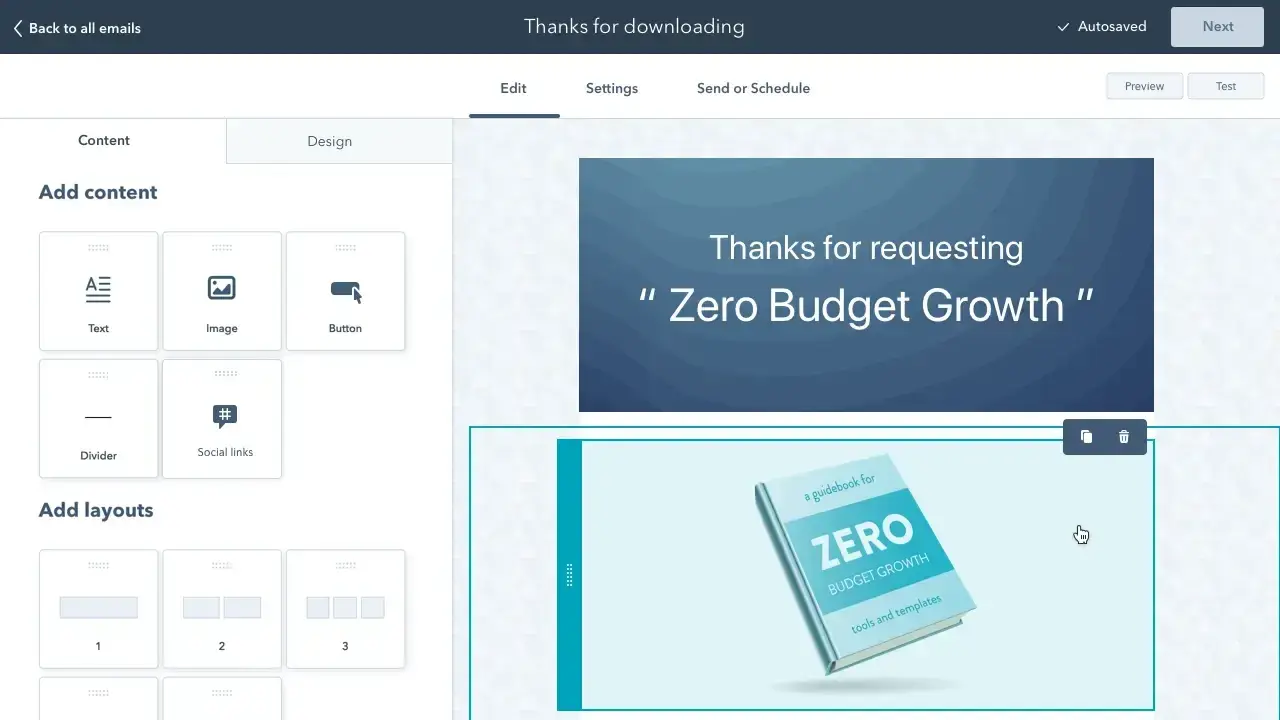
How long should an email sequence be?
When we set out to design an automated email sequence, we quickly realized there was no magic number.
The length depends entirely on who you’re talking to, where they are in their buying journey, and how long your typical sales cycle runs. But here’s what mattered most to us: every email needed a job.
Defining Our Goals: What We Focused On
Here’s how we approached our nurturing sequence:
- Educate prospects along their path to purchase. We started with emails that shared customer success stories and practical tips.
- Handle objections before they arise. We addressed common concerns upfront, using FAQs and a comparison guide that highlighted our unique edge.
- Establish our authority and build trust. Our welcome email shared industry insights and a free resource, positioning us as experts from day one.
- Stay top-of-mind until they’re ready to buy. We followed up with value-packed newsletters. No hard sells, just helpful insights.
As we refined our sequence, we looked to successful examples in the field. Take food photographer Regan Baroni. She mastered the art of nurturing leads while positioning herself as an industry expert. Here’s how her approach inspired us:
- She used free resources — like “5 Tips for Better Food Photos” — to educate and engage her audience.
- She addressed objections (“Can I afford professional photos?”) with case studies that showed how her work boosted her clients’ bookings.
- She built trust by sharing her process upfront and highlighting testimonials from happy clients.
- She stayed top-of-mind with a monthly newsletter offering photography tips and behind-the-scenes content.

Key Takeaways for Your Next Email Sequence
In the end, it wasn’t about how many emails we sent — it was about how well each one guided prospects toward a decision. Here’s what we learned:
- Make every email count. Focus on education, trust, and consistent value.
- Address objections head-on. FAQs, comparisons, and testimonials help prospects move forward.
- Stay helpful, not pushy. Nurture your audience with insights, not just offers.
The takeaway? Build sequences that nurture, not nag. Give value, answer objections, and stay helpful every step of the way.
How to Create an Email Sequence
So, we’ve covered what email sequences are, when to use them, and how long they should be. Now, let’s dive into how we create personalized sequences tailored to our audience and how you can do the same.
1. Determine the sequence’s purpose.
Before building our automated workflows, we got crystal clear on why each sequence existed. Every sequence needs a job. Are you:
- Driving a direct action? (e.g., booking a demo)
- Nurturing a lead? (e.g., turning ebook downloads into SQLs)
- Re-engaging cold contacts? (e.g., reviving dormant leads)
When you define the goal upfront, you can measure success and guide prospects toward the next step in their journey. Here’s how we approached it.
Follow-up Sequence: Converting Conversations Into Demos
Prospects are most engaged right after a conversation. This is your moment to drive action.
How we structured ours:
- Email 1. Recap the conversation and share promised resources. (Sent immediately)
- Email 2. Follow up with a client success story or testimonial. (Day 3)
- Email 3. Send a friendly nudge with a calendar link. (Day 5)
Here, our KPI was a prospect booking a meeting through our scheduling software.
Nurturing Sequence: Turning Content Leads Into SQLs
Not every lead is ready to buy, but they are ready to learn. Educational touchpoints build trust and keep you top-of-mind until they are ready to engage.
How we built ours:
- Email 1. Provide a resource aligned with the ebook they downloaded.
- Email 2. Share a webinar invite or a case study tackling their pain point.
- Email 3. Softly introduce your solution with a CTA like “Ready to explore how this could work for your business?”
Our nurturing campaign didn’t just educate. It converted leads into sales-qualified leads (SQLs) and primed our pipeline for success.
Whether you’re following up, nurturing, or re-engaging, every sequence should have a clear outcome.
2. Identify the enrollment criteria (or trigger) for the sequence.
You’ve built your email sequence. Now what? Without the right triggers, it just sits there, waiting. Triggers are what launch your automation at the perfect moment, turning clicks, downloads, and meetings into real opportunities.
When we set up our automated workflows, enrollment criteria were everything. They’re your automation’s “on switch,” the rules that decide who gets your emails and when.
Set them right, and your workflows run smoothly, delivering emails when they’re most effective. Set them wrong or skip them, and you risk losing leads before they even reach your inbox.
Common Enrollment Triggers (and When to Use Them)
Different triggers serve different goals. Choose the ones that match your sequence’s purpose.
Lead Capture Triggers: Start nurturing sequences when a lead takes action.
- When a contact submits a form (e.g., downloads an ebook).
- When a contact subscribes to your newsletter.
Behavioral Triggers: Follow up based on what a contact does.
- When they visit a high-intent page (like pricing or case studies).
- When they click a key link in an email.
Lifecycle Stage Triggers: Automate sales outreach based on lead qualification.
- When a contact moves from MQL to SQL.
- When they engage with a specific sales pipeline deal stage.
Event-Based Triggers: Respond immediately to key moments.
- When they book a meeting (send a confirmation and pre-call resources).
- When they miss a meeting (trigger a re-engagement sequence).
How We Used Triggers
Here’s how we applied these triggers with our automated workflows:
- Sales Follow-Ups. We manually enrolled qualified leads after discovery calls using our CRM. No hot lead got left behind.
- Content Nurturing. A simple ebook download triggered a three-step nurturing sequence that moved leads from interest to SQL.
- Demo No-Shows. A missed meeting auto-triggered a follow-up sequence with a new calendar link and a friendly re-invite.
Each trigger ensured our automation reached leads at exactly the right time — when engagement was highest.
Pro tip: No matter which triggers you use, your automation is only as good as your data. We learned this the hard way — one misconfigured property caused us to email old leads with the wrong offers (ouch). Now, we regularly audit our CRM to ensure every trigger is accurate and every workflow fires as expected.
If you’re using HubSpot (like we did), you can create triggers using properties like page views, form submissions, or lifecycle stages.
Bonus: HubSpot’s built-in filters help ensure only qualified leads enter your sequences — so you send the right emails to the right people. Learn more about HubSpot’s enrollment criteria here.
3. Determine the duration of the sequence and the number of emails required.
Your prospects’ inboxes are crowded. Hundreds of emails compete for their attention every day. So, how do you make yours the one they actually open, read, and act on? It starts with getting your timing and touchpoints just right.
When we built our automated workflows, we didn’t guess how many emails to send or when to send them.
We built our cadence around the buyer’s journey. The length and frequency of the sequence had one job: Move leads step-by-step toward conversion without overwhelming them.
Here’s how we planned our sequence and how you can, too.
Sales Follow-Up Sequence: Matching the Sales Cycle
Since our average sales cycle was about 30 days, we planned twice-a-week touchpoints, enough to stay top-of-mind without spamming. That meant:
- 8 emails over 30 days. We spaced them out to nurture interest, answer objections, and drive action.
- Each email had a purpose. From recapping the conversation to sharing success stories and offering a clear path to book a demo.
The result? Higher engagement and more meetings without adding more manual follow-ups to our workload.
Nurture Sequence: Pacing for Long-Term Engagement
When leads downloaded our ebook, we knew they weren’t ready to buy yet. Instead of rushing, we built a slower, value-driven sequence:
- Five emails over 45 days, delivered weekly.
- Each touchpoint delivered actionable insights, case studies, or resources to educate. By the time we introduced a soft CTA, our leads already trusted us, which made conversions easier.
Short Follow-Up Sequence: Timing for Warmer Leads
Not every sequence needs eight emails. For follow-ups after face-to-face meetings, we kept it short and personal:
- Three emails over seven days, then a task to follow up by phone (automated through our CRM).
- Short, friendly reminders plus a “just checking in” note kept the conversation going without feeling pushy.
Our Framework for Sequence Planning
When mapping your sequence, start with your goal and work backward:
|
Sequence Type |
Typical Length |
Best For |
|
Sales Follow-Up |
6–8 emails over 30 days |
Shorter sales cycles, demo conversion |
|
Nurture Campaign |
4–7 emails over 45 days |
Longer buying journeys, content leads |
|
Post-Meeting Follow-Up |
2–3 emails over 7 days |
Warm leads from calls or events |
It’s not about how many emails you send. It’s about when and why you send them. The best sequences meet prospects where they are — with the right message at the right time.
4. Write the emails for the sequence.
Once we had our sequence mapped, it was time to write emails that didn’t just land in inboxes. They hit a nerve. Forget generic “just checking in” emails.
We built every email around a pain point our prospects were already feeling, then showed them how to fix it.
Here’s how we approached email copywriting and how you can, too.
1. Every email had a job built on pain, not a pitch.
We refused to write “just following up” emails. Every email attacked a frustration, showed what it was costing them, and then offered a way out. Our emails did one of three things:
- Expose a pain. Call out a problem they already know is killing their progress.
- Agitate the cost. Show them what happens if they don’t fix it without fear-mongering.
- Offer a path forward. Position the call-to-action (CTA) as relief from their frustration.
2. We wrote evergreen emails but made them feel personal.
To scale, we kept emails evergreen, but every line felt like it was written just for them. We did this by:
- Behavior-based hooks. We started every email with why they were getting it.
- “I noticed you downloaded [resource], so you might be hitting this roadblock…”
- “You visited our pricing page, so I’m guessing [common hesitation] might be on your mind.”
- Sharp personalization. We went beyond personalization tokens and referenced their role, problem, and industry.
3. Our proven pain-point email structure.
We used a simple structure that kept every email short and impossible to ignore.
- Subject: Name the problem or consequence (“How long can you afford this?”).
- Opening: Go straight to the pain. Skip the small talk.
- Agitate: Show what it’s costing them.
- Solution: Offer a way out. Keep it short.
- CTA: Simple, low-commitment action (“Want to see how this could work for you?”).
Example 1: “Silent Killer” Email
Sent: When they downloaded a resource.
Subject: [First Name], is [pain point] quietly killing your pipeline?
Hi [First Name],
You downloaded [resource], which tells me you’re trying to fix [problem]. But here’s the thing:
The biggest killer of pipeline deals isn’t a bad product. It’s silence.
And that silence usually happens because:
- Your follow-ups come too late or not at all.
- Your emails blend into a sea of “just checking in.”
- You stop reaching out after two touchpoints (when most conversions happen after five).
The cost? More lost deals. More ghosted demos. And more “we went with someone else” emails.
Want to see how [Company X] fixed this and booked 35% more demos without manual follow-up?
Here’s a quick link to chat: [Calendar Link]
[Your Name]
Example 2: “Stop Wasting Warm Leads”
Sent: To pricing page visitors
Subject: [First Name], how many warm leads are you losing like this?
Hi [First Name],
Saw you checked out our pricing page, so I’m guessing you’re weighing your options. But here’s the real cost to consider:
How many warm leads are you losing before they even decide?
Most teams don’t lose deals at the pitch; they lose them in the follow-up gap. Here’s why it happens:
- Your fastest competitor responds first (and wins the deal).
- Leads go cold when they don’t hear from you quickly enough.
- You give up too soon. Most conversions happen after 5+ touchpoints, but most teams quit after 2.
We built an automated workflow that fixes this, and it helped [Company Y] increase conversions by 40%. Want to see how it works? Here’s a time: [Calendar Link]
Best,[Your Name]
Example 3: “They Chose Someone Else”
Sent: To handle objections
Subject: [First Name], here’s why they went with your competitor.
Hi [First Name],
Ever lost a deal to a competitor and thought: “But we were the better fit”?
It wasn’t your solution. It was your timing. Here’s why most teams lose deals they should win:
- They reply too slowly: By the time they follow up, the prospect’s moved on.
- Their follow-ups sound like templates. Zero relevance, Zero replies.
- They stop too soon. 80% of deals need 5+ touchpoints, but most teams quit after 2.
[Company X] fixed this with an automated follow-up sequence that:
- Replied to new leads within 5 minutes — automatically.
- Sent 6 touchpoints over 21 days — without adding manual work.
- Increased demo bookings by 40% — without hiring more reps.
Want to see how this could work for your team? Let’s find 15 minutes: [Calendar Link]
Best,[Your Name]
Pro tip: The highest-converting emails don’t “sell.” They expose the pain your lead is already feeling and make your solution the obvious way out.
5. Build the emails using email software.
With our emails written and ready to convert, it was time to bring them to life in our email software. This is where strategy meets execution because even the best emails won’t drive results if you build them poorly or send them at the wrong time.
Here’s how we built our emails.
Sales vs. Marketing Emails: Matching the Build to the Goal
We didn’t treat every email the same. We matched how we built the emails to what they needed to do.
- Sales Sequence Emails. Plain-text, no heavy formatting because personal, one-to-one emails from a rep drive more replies.
- Marketing Nurture Emails. Structured layouts with headers, CTA buttons, and visuals because these emails needed to educate, nurture, and drive clicks.
Here’s how we build out emails:
- Copy the text into the Email Builder. Paste directly. No fancy formatting that breaks on mobile.
- Match the email to its goal.
- Sales emails: Plain-text with a clear reply prompt.
- Marketing emails: CTA buttons, headers, and scannable sections.
- Add personalization tokens. [First Name], [Company], or [Last Action] — small touches that make a big impact.
- Embed tracking links. Add UTM parameters to every CTA to measure performance.
- Set previews and snippets. Write preview text that complements your subject line — don’t leave it to default.
- Check mobile view. Test button sizes, font spacing, and load times.
- Test deliverability. Run a spam check to catch issues before hitting “send.”
Pro tips:
- Use plain-text for sales and visuals for nurture. Sales emails should feel like personal outreach, nurture emails should guide clicks.
- Keep emails under 125 words. Short emails are less overwhelming and get more replies.
- Be sure all images have ALT text. If images fail to load, your message still gets through.
- Over half of your leads will open on their phone — make it easy to read and reply on mobile.
Great copy without clean, mobile-optimized delivery is like a billboard in the desert. Make sure your emails don’t just say the right thing. They should show up the right way, too.
6. Set up the automation.
This is where everything came together. With our emails ready, it was time to automate — because a sequence only works if it reaches the right lead with the right message at the right time.
Here’s how we set it up — and how you can, too.
Sequence Structure
When building automation workflows, every sequence followed this simple structure:
- Trigger (When). What action starts the sequence? (e.g., Downloading a guide).
- Action (What). What happens next? (e.g., Send Email 1).
- Timing (Pacing). How long between each email? (e.g., Wait 3 days).
- Logic (If/Then). What happens based on their behavior? (e.g., If they reply, exit the sequence).
Example: Our Sales Follow-up Workflow
Scenario: Following up with leads who booked a discovery call but didn’t convert.
- Trigger. Contact books a discovery call but doesn’t move forward.
- Email 1 (Day 1). Thank-you email + case study link.
- Wait 3 days. If no response …
- Email 2 (Day 4). Share a customer success story with a clear outcome.
- If they click the link, create a task for a sales rep to follow up personally.
- If no click after 5 days, Send a final “door closing” email.
Here are some resources for working with HubSpot’s automation tool:
Pro tips:
- I recommend starting simple triggers + follow-ups first — then adding conditions as you learn.
- Use delays wisely. A “Wait 2 days” delay outperforms immediate sends — less pressure, more response.
- Score your leads automatically. Add points for clicks, replies, or bookings — then notify sales when they’re hot.
- Add exit conditions. Stop the sequence if they convert — no one likes “Did you get my email?” after they booked.
7. Test the sequence.
We learned this the hard way: One broken link can kill a campaign, and one personalization error can kill trust. Testing isn’t a checkbox — it’s how we made sure every email worked before it reached a prospect’s inbox.
Here’s how we tested our sequences:
- Proofread for clarity and errors. Triple-check spelling, links, and personalization tokens. If there’s a typo, readers will see it.
- Test across devices. Don’t lose conversions to bad formatting or poor rendering on different devices.
- Check deliverability. Run the email through a tool like GlockApps or MailTester — because emails that land in spam never convert.
- Verify personalization tokens. Send a test email to yourself. If you see “[First Name],” so will your leads.
- Test timing and triggers. Preview the automation and run a test contact through the sequence — broken triggers mean broken campaigns.
In one of our early sequences, we missed a personalization token, and every email opened with:
“Hi [First Name],”
The result? A 20% drop in replies. Worse, some leads replied just to point out the error which is not great for trust. Since then, testing personalization has been our first checkpoint — every time.
Email Sequence Examples
You’ve sent follow-up emails, but what other sequences can drive engagement?
7 Email Sequence Examples
Let’s explore seven powerful email sequences you can use to captivate your prospects.
1. Nurturing Email Sequences
A nurturing sequence introduces the prospect to you, your company, and your offerings. It’s often called a welcome sequence. Subscribers may have downloaded an ebook or opted into a content offer, but that doesn’t mean they’re sales-ready.
A nurturing sequence builds trust by showing social proof, handling objections, and demonstrating value.
Here’s an example from Moment:
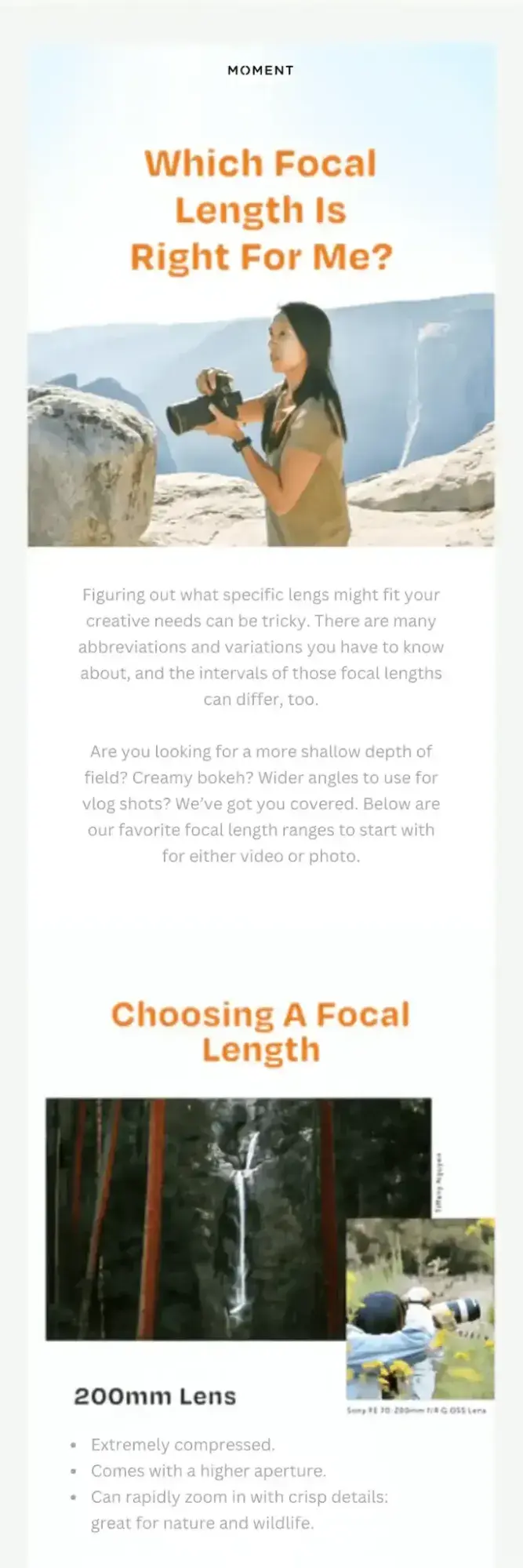
This type of sequence is ideal for companies with short sales cycles, such as consumer packaged goods or simple B2B digital tools.
To get the best results from a nurturing sequence, I recommend focusing on educating your prospects, not selling to them. Share valuable tips, resources, or insights. Build trust, and when they’re ready to buy, you’ll be top-of-mind.
What I like: Moment uses its nurturing email to stay educational rather than salesy. It feels warm and authentic. The email builds trust by showing the value upfront without pushing the product.
If I were receiving it, I’d appreciate the helpful tips that make me feel like the company understands me as a customer. Plus, it’s short and sweet, just right for a nurturing email.
Pro tip: Keep these emails simple and value-focused. A short story, a testimonial, or a quick resource can work wonders.
2. Onboarding Email Sequences
After you sign up for a service, what’s the first thing you want? Clear direction. That’s where onboarding email sequences come in.
An onboarding email can be as simple as a welcome message or a straightforward outline of the next steps.
These sequences can be plain text and direct — you don’t need fancy designs. Since new customers expect to hear from you, open rates are usually high.
Here’s an example of an onboarding email from Writing From Nowhere:

What I like: I like how Writing From Nowhere keeps its onboarding email direct and approachable. It’s plain text, which feels personal — almost like a message from a friend.
The email offers a clear next step. No overload, just what I need. Because it’s simple and fluff-free, it sets the tone for a smooth working relationship: direct, fast, and trust-building.
Pro tip: Make the first email fast, friendly, and useful. Include a single, unmistakable action they can take immediately to get started.
3. Engagement Email Sequences
An engagement email sequence uses email to build rapport with prospects. The goal is to get them to click, reply, or share your content so you stay top-of-mind.
Here’s an example of an email in an engagement sequence from A Kids Book About:
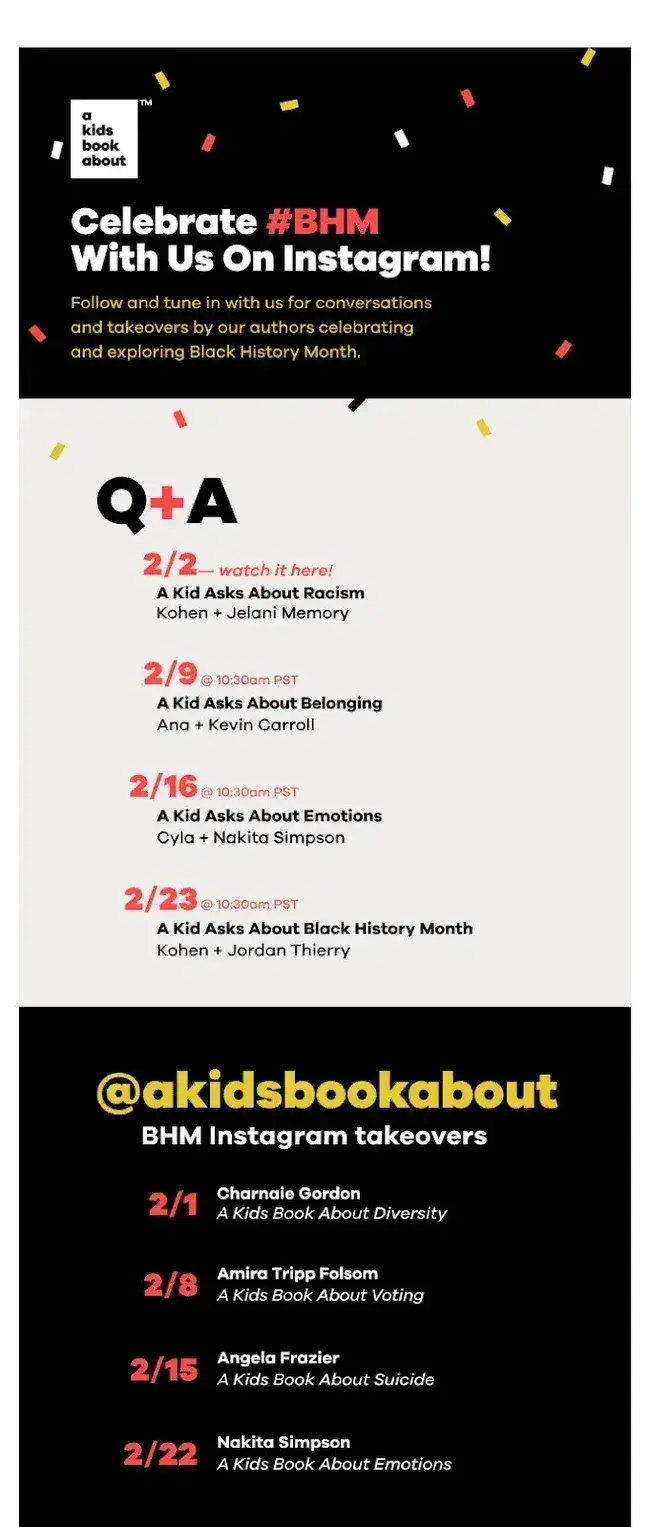
In this email, A Kids Book About promotes upcoming events with clear dates and titles, making it easy for readers to decide which ones to attend. The layout is clean, with event details front and center. No hunting for information. Plus, the subject line builds excitement without being clickbaity.
This type of sequence is perfect for brands with frequent events, launches, or content updates.
Engagement emails work best once you’ve already built some relationship — when recipients look forward to your emails.
What I like: This email gets straight to the point, with dates, titles, and why the reader should care. It feels organized but not overwhelming. The design makes each event easy to skim, which I’d appreciate if I were busy but curious.
What really stands out to me is how they balance promotion with value. They aren’t just saying, “Come to our event.” They’re making it easy for me to choose which event is right for me. If I were a subscriber, I’d feel like they respect my time by keeping it brief but useful.
Also, I love how they build anticipation without shouting. There is no over-the-top urgency; it is just, “Here’s what’s happening; we’d love to see you.”
That approach feels more authentic and community-driven, which perfectly fits their brand.
4. Conversion Email Sequences
A conversion email sequence is designed to drive action, whether it’s booking a meeting, scheduling a demo, or claiming an offer.
Unlike nurturing or engagement emails, conversion emails are direct: the goal is to turn interest into commitment. These emails should be clear, concise, and centered around a single CTA.
Great conversion emails often use these strategies:
- Identify the reader’s persona or archetype. Call out their pain points to show you understand their needs.
- Focus on a specific problem. Position your solution clearly and tie it to their goals.
- Keep one clear CTA. Don’t confuse the reader: one button, one action.
- Add social proof. Use testimonials or results to remove doubt.
Here’s an example from Yokel Local:
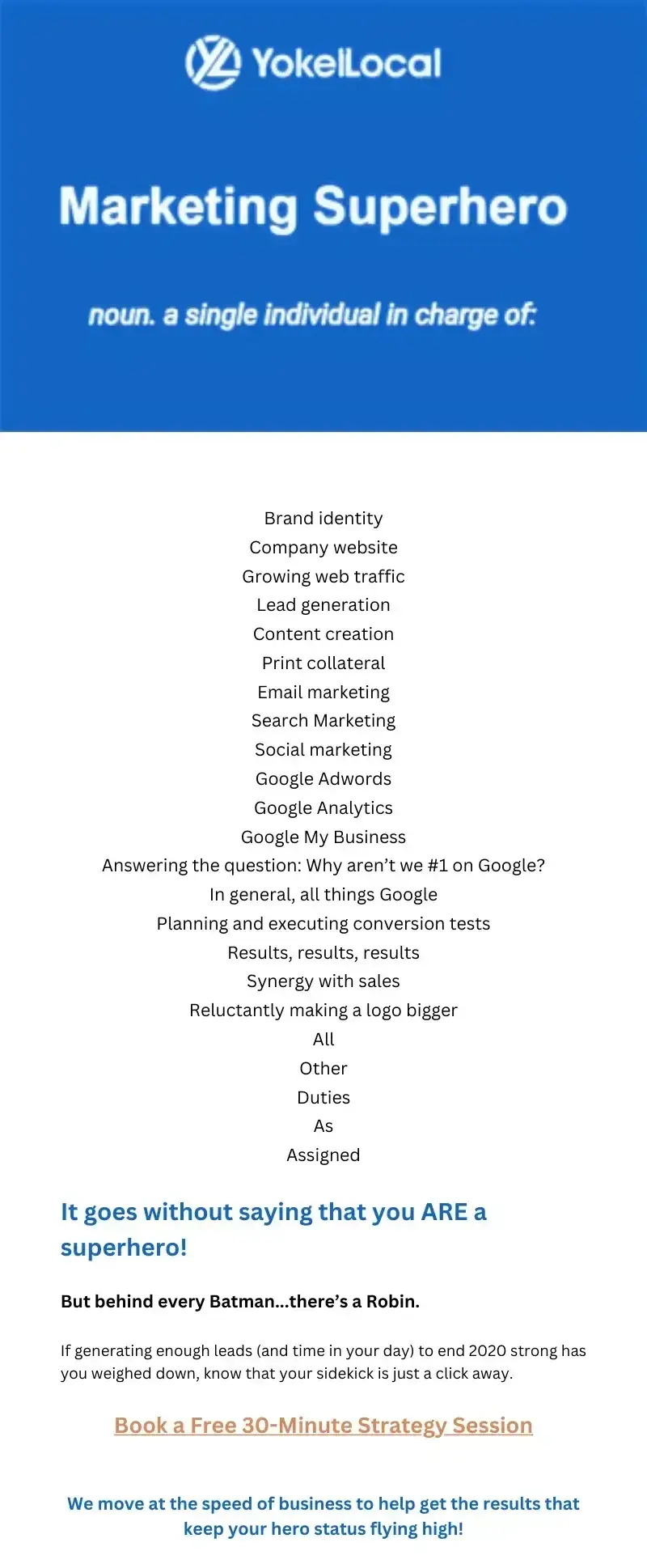
In this email, Yokel Local opens by addressing the different roles a reader plays in their business, immediately making them feel seen.
They zero in on a common pain point: struggling to generate leads. The email quickly shifts to a solution: Book a meeting to solve your lead generation challenges.
The layout is clean and purposeful: one bold CTA button, “Book a 30-minute free strategy session,” so there’s no confusion about the next step. Plus, they use customer results to build trust — letting outcomes, not promises, do the selling.
What I like: I really like how Yokel Local structures this email. It feels personal and targeted.
I also like how they identify the problem (too much work to do, taking their focus away from lead generation) and tie it directly to their solution (book a meeting for help). No jargon, no fluff.
5. Follow-up Email Sequences
A follow-up email sequence is designed to reconnect with prospects who haven’t responded to your initial outreach. Just because someone didn’t reply doesn’t mean they’re not interested.
They may be busy, unsure, or need a reminder. Follow-up emails are crucial for keeping the conversation alive without being pushy.
Great follow-up emails often:
- Keep it short and polite. Respect their time. Brevity is key.
- Acknowledge the silence. A soft nudge works better than a hard sell.
- Re-state the value or offer. Quickly remind them why they should care.
- Have one clear CTA. Make it easy for them to take action.
Here’s an example of a follow-up email:

What I like: This follow-up email is simple but effective. It opens by politely checking in. No pressure, just a quick “Following up” to stay on their radar.
Then, it restates the value: solving their productivity problems. Finally, it closes with a clear, easy CTA, “Schedule a call,” making it effortless to respond.
The value reminder is quick but sharp. There is no long pitch, just a clear solution to their pain point (productivity). If I were on the fence, this email would remind me why I reached out without overwhelming me.
6. Re-Engagement Email Sequence
A re-engagement email sequence is designed to win back subscribers who have gone cold. People who stopped opening your emails or engaging with your content. The goal is to remind them why they signed up and rekindle their interest.
Great re-engagement emails often:
- Acknowledge the inactivity. Be direct. Let them know you’ve noticed they’ve been quiet.
- Offer value or an incentive. A free resource, discount, or exclusive content can re-spark interest.
- Make it easy to stay connected. One-click options to update preferences or re-subscribe.
- Give them an opt-out option. It’s better to clean your list than keep disinterested contacts.
Here’s one of our account deletion re-engagement emails:
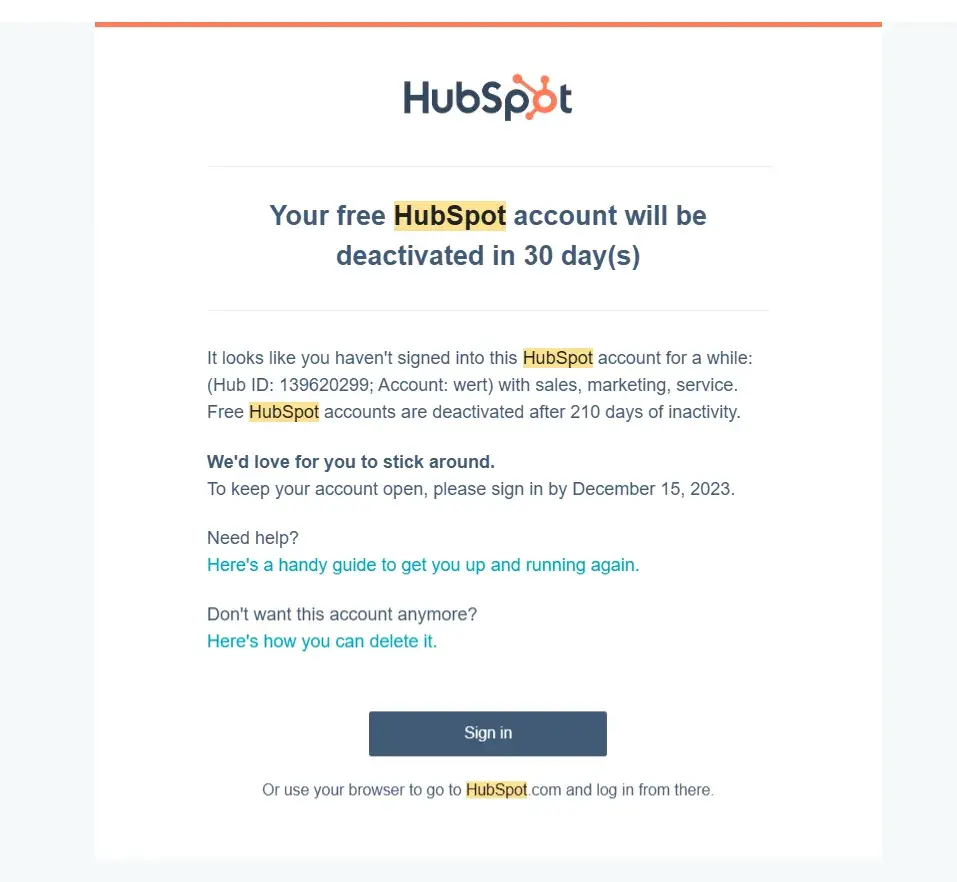
What I like: I like how this email gets straight to the point. The subject line alone, “Your HubSpot account will be deactivated in 30 days,” grabs my attention because it’s specific and urgent. If I were disengaged, this would make me pause and consider taking action.
The design is minimal and effective: no clutter, no unnecessary images. Just a clear warning and a big, easy-to-spot “Sign in” button. I love this because there’s zero friction. One-click, problem solved.
Plus, they give me a deadline (30 days) but without panic-inducing language. The balance is perfect: firm but friendly.
7. Reminder Email Sequences
A webinar reminder email sequence is designed to ensure registrants don’t forget the event. Even if someone signs up, life gets busy, and reminders boost attendance rates.
Great webinar reminder emails often:
- Keep the subject line clear and time-sensitive. Simple lines like “[Webinar Name] starts tomorrow!” or “Don’t miss us at 2 PM!” drive urgency.
- Reinforce the key details. The time, date, and webinar link should be instantly visible.
- Offer an easy calendar add. A quick “Add to Calendar” button reduces no-shows.
- Build excitement with value. Briefly remind attendees what they’ll gain by attending.
Here’s an example from Dyspatch:
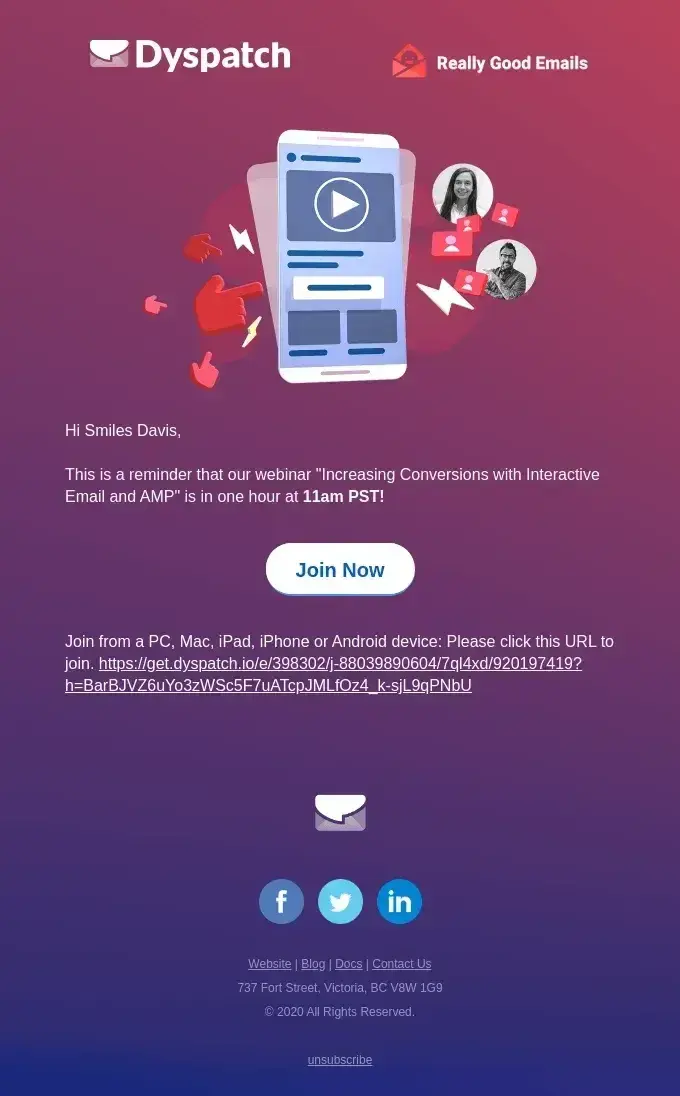
In this email, Dyspatch does a great job of making the details crystal clear: the webinar title and time are right at the top.
What I like: I like how well-designed this email is. It’s straight to the point and easy on the eyes. The clean layout and bold headings make the essential details impossible to miss. I’d know exactly when and where to join the webinar within seconds of opening the email.
The best part is the direct “Join Webinar” button, which is clickable and right up front. If I were rushing between meetings, this would be a lifesaver. I hate when webinar reminders bury the link halfway down the page.
The Email Sequence That Made Us $100,000
What if you could turn a simple email sequence into $100,000 in 30 days? That’s exactly what we did — without paid ads, a huge list, or complex funnels. And now, we’re breaking down every step so you can do the same.
This sequence worked because it tapped into three powerful emotions that drive action:
- Recognition (Pride). People love being acknowledged as it grabs attention instantly.
- FOMO (Regret). If they don’t act, they’ll lose out on an opportunity their competitors might seize.
- Reciprocity (Gratitude). Provide value, insights, or tools, and they’ll feel compelled to engage.
Here’s exactly how we built this sequence, from finding the right leads to sending the perfect follow-ups. Every step, every email, and every insight that made this work.
Step 1. Find prospects who are mentioned in the news.
As a branding agency in the healthcare industry, the majority of our clients are doctors or dentists. To hit $100K in 30 days, we needed the right leads.
Our target? The doctors and dentists featured in the news. These professionals were getting attention but didn’t always know how to capitalize on it. That’s where we came in. Most businesses chase cold leads. We focused on warm prospects: professionals already being talked about who just needed help leveraging that visibility.
And the best part? These leads weren’t just warm — they were likely to reply because we weren’t selling, we were congratulating.
How We Found Them
1. Set Up Google Alerts to automate lead discovery.
- Go to Google Alerts.
- Enter industry-specific keywords (e.g., “orthopedic surgery” or “cosmetic dentistry”).
- Click Create Alert to get email notifications whenever relevant articles are published.
2. Use Feedly for Industry News (Curated Lead List)
- Sign up for Feedly and create a new feed.
- Add high-authority industry websites (e.g., KevinMD.com, TEDmed.com, AdWeek).
- Check the feed daily for doctors or dentists who are getting media coverage.
In the example below, we track the keyword “orthopedic surgery” in Google Alerts. After entering the keyword and my email address, I click “Create Alert.” Now, I will receive an alert any time the news mentions orthopedic surgeries or orthopedic surgeons.
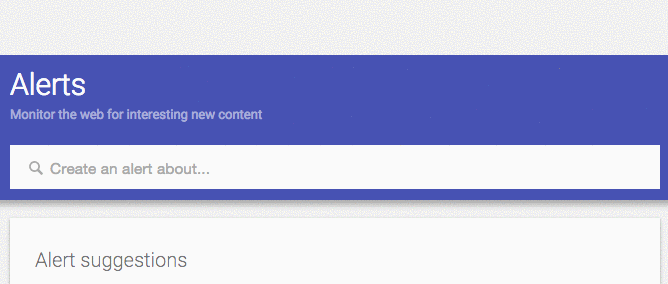
Feedly is another tool to use when monitoring news topics. It is a space where you can privately organize and research topics relevant to you. It is an alternate tool Feed the Agency uses to discover doctors mentioned in the news.
To use the platform, add websites to your “feed.” When a website you’re monitoring publishes a new article, you’ll receive an alert within the platform.
For example, a website we follow in our industry is KevinMD.com. To add it to our feed, I:
- Click “+Add Content.”
- Enter the URL in the search bar: KevinMD.com.
- Click the green “+Feedly” button.
- Click “Add.”
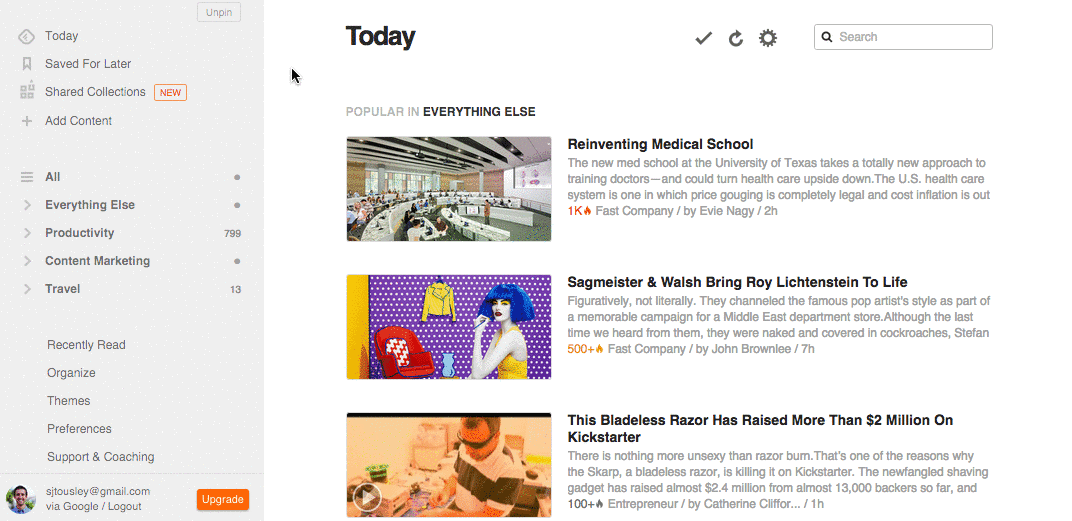
In those four steps, we added KevinMD to our feed. TEDmed.com, AdWeek, and Advertising Age are other websites we’ve used to acquire new customers. They are examples of other websites I have added to my Feedly account.
To view the content from these websites, I click on the “Health” tab, where all the content appears at once.
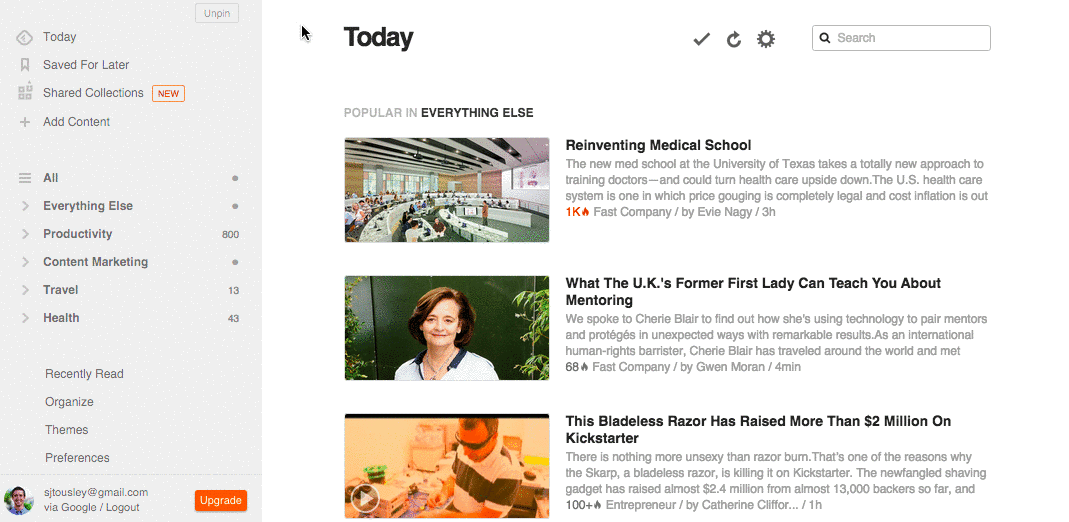
Step 2. Send an email congratulating them on their news coverage.
Finding the right prospects is only half the battle. The first email determines whether they engage or ignore you. Our goal? A warm, non-sales introduction that stands out from the dozens of emails cluttering their inbox.
Using the free email templates builder from Sales Hub, here’s one of the emails we sent in our first outreach:
Subject: Dr. [Last Name], saw your feature — quick question
Hi Dr. [Last Name],
I saw your feature in [Publication]. Congratulations — great to see your expertise getting recognized.
Many doctors we’ve worked with tell us that after a big media feature, patient inquiries spike — but so do branding challenges. Suddenly, you’re more visible, but are the right patients finding you?
We recently helped Dr. [Similar Name] turn their media exposure into a 30% increase in patient inquiries — without relying on expensive ad campaigns or generic marketing.
If you’d like to learn how we did it, let’s set up a quick call. Please schedule 15 minutes on my calendar.
Best,
Matthew

Why this works:
- There’s recognition first. Opens with genuine congratulations, making the email feel personal.
- We use the pain point hook. Taps into a challenge they may not have considered yet.
- There’s a soft CTA. No “hard sell” or meeting request — just an offer to help.
If they don’t respond within 24 hours, we follow up with Email 2: A personalized and valuable offer.
Step 3. Send a follow-up email with helpful content personalized to their industry.
Not every prospect responds to the first email, and that’s normal. The key to a great follow-up isn’t just “checking in”; it’s offering something so valuable they can’t ignore it. This email shifts the conversation from a simple introduction to real value, positioning us as a trusted resource, not just another pitch.
Email Template – Follow-Up with a Personalized Tool
Subject: Dr. [Last Name], I made this for you
Hi Dr. [Last Name],
I know you’re busy, so I’ll keep this quick. I reached out earlier about your recent feature in [Publication] — and I put something together that might help you make the most of that momentum.
It’s a Physician Brand Differentiation Survey that reveals how your practice stands out, or doesn’t, compared to other top doctors in [City]. Most doctors are surprised by what they find.
See how your brand compares. Take the 3-minute survey here. [Insert Link]
When we speak, I’ll compare your results to those of the top physician brands nationwide. If you’d like to discuss your results, please schedule a time here: [Calendar Link].
Best,
Matthew

Add names whenever possible. Adding a doctor’s name to the survey increased our response rates.
Although it was a small tweak, personalization is a powerful tool. If this email fails to drive prospects to reply or book time on my calendar, I’ll send a second follow-up email using the “Trying to Connect” email template.
Step 4. Handling No response (The “Trying to Connect” Email)
At this point, we’ve sent two emails with no response. That doesn’t mean they’re not interested — it means they’re busy or undecided. This email keeps the conversation alive by removing pressure, offering flexibility, and making it easy to say “yes.”
Email Template – The “Trying to Connect” Email
Subject: Still interested? I can make this easy.
Hi Dr. [Last Name],
I know your schedule is packed, and I want to make this as easy as possible for you.
Many physicians tell me they’re too busy to think about branding — until patient inquiries slow down or competitors start taking market share. I’d hate to see that happen when a simple shift could keep you top-of-mind with the right patients.
I’m happy to accommodate your schedule, including early mornings or weekends.
Let me know what works, or schedule a time here: [Calendar Link]. If now isn’t the right time, just reply “later,” and I’ll follow up in a few weeks.
Best,
Matthew

Why this works:
- The message has a confident but low-pressure tone. No apologies, just an easy way forward.
- The writer reintroduces the pain point subtly. Reminds them why this matters.
- The writer gives them an easy out. “Reply later” reduces friction and keeps the door open.
If there’s still no response, we move to Email 5, the “Permission to Close” Email, where we introduce scarcity and force a decision.
This single email had the highest response rate of all the templates. Why? Offering extended hours could be the key.
Without mentioning explicit hours, prospects might automatically assume that scheduling times are during their business hours. Offering times outside of regular “9 to 5” hours can push prospects to take action.
Step 5. The Final Follow-Up (“Permission to Close Your File?”)
Silence doesn’t always mean “no” — sometimes, it just means “not yet.” But instead of chasing unresponsive leads, we shift the power dynamic. This email works because it gives them two options: engage now or lose the opportunity forever. The fear of missing out does the rest.
Email Template – The “Permission to Close” Email
Subject: Dr. [Last Name], should I take you off the list?
Hi Dr. [Last Name],
I wanted to follow up one last time. We’re finalizing our client list for the month, and I wasn’t sure if you still wanted to explore how to turn your recent media coverage into a patient growth strategy.
I don’t want to clutter your inbox if this isn’t a priority. But if you’re still considering it, now is the time — we won’t be reopening spots for another few months.
Just reply “yes” if you’d like to schedule a call or “close” if now isn’t the right time. Either way, I’ll take care of the next steps.
Best,
Matthew

Why this works:
- The message applies subtle scarcity. Frames this as a now-or-never decision.
- The email keeps it effortless to respond. A one-word reply makes it easy to act.
- The writer maintains authority. No begging, just a professional close-out.
If they don’t respond? We move on. The worst thing you can do is keep chasing dead leads.
Step 6. Improve your email sequence templates by measuring their performance.
A sequence is only as good as its results. Even a well-written email can fail if it’s sent at the wrong time, to the wrong person, or with the wrong message. That’s why tracking performance isn’t optional.
HubSpot’s free email templates tool allows you to measure open rates and click rates. These templates give you the potential to get similar results. Try it out. Create a free HubSpot account, open the email templates tool, and click send.
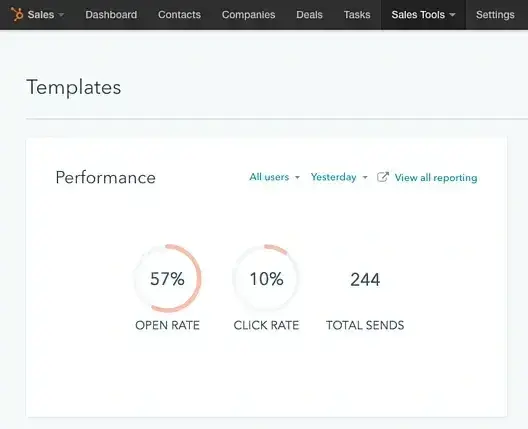
At Feed.The Agency, we measured email performance and made improvements as we saw fit.
We didn’t just track numbers. We used them to make strategic changes. Here’s what we measured:
- Open Rate. Did our subject lines work? (Target: 50% or higher)
- Reply Rate. Did the email drive engagement? (Target: 10% or higher)
- CTA Click Rate. Were people taking action? (Target: 15% or higher)
- Conversion Rate. How many leads booked a call? (Target: 5–10%)
Key insight from our testing:
One small tweak made a huge difference: We changed the subject line of Email #1 from “Free to chat?” to “Dr. [Last Name], saw your feature — quick question.” That alone increased open rates from 42% to 58%.
Our Email Optimization Framework
We didn’t guess our way to better results. We tested systematically by:
- Identifying the weakest link. We identified the underperforming metrics: Open rate, replies, clicks, or conversions.
- A/B testing. When running an A/B Test, we changed only one variable at a time: the subject line, CTA, or timing.
- Tracking and comparing. We measured results over 7–14 days. Keep what works, discard what doesn’t.
- Refining and scaling. We applied winning changes across the entire sequence.
If you don’t track and refine, you’re wasting money. The only way to build a high-performing email sequence is to test, tweak, and optimize it repeatedly.
Email Sequence Best Practices
No matter the kind of email sequence you’re creating, there are some best practices you have to keep in mind to ensure that you get the best results possible.
1. Set SMART goals.
Ever feel like your email sequences are just shots in the dark? That’s where SMART goals come in.
Before starting an email sequence, ask yourself: What do I want to achieve with this?
All email sequences have goals, but only SMART goals make success measurable. For example, a lead nurturing sequence might aim to gain 100 webinar signups in 14 days, while an abandoned cart sequence could target a 10% recovery rate within a week.
When setting goals for your sequences, make sure they’re SMART — Specific, Measurable, Achievable, Relevant, and Time-Bound. This framework ensures that you set realistic goals and achieve them on or before the deadline you set.
Here’s how to apply SMART goals in action:
For a welcome sequence, a goal could be: “Convert 5% of new subscribers to customers within 30 days by offering a limited-time discount.”
Without clear targets, your email sequence becomes guesswork. That’s why I think SMART goals are essential — they help you track success and adjust when needed.
Before you draft your first email, write down your SMART goal and how you’ll measure success.
2. Create an outline for your email sequence.
Ever stare at a blank page, unsure where to start your email sequence? That’s where an outline saves the day.
Creating an outline will help you determine how many emails will be in each sequence. Write down everything you want to include in your emails. When you’re done writing out your ideas, group similar topics into categories.
When grouping your ideas into categories, think about your sequence’s purpose. For example:
- If you’re launching a product, group emails into categories like ‘Product Benefits,’ ‘Customer Stories,’ and ‘Limited-Time Offers.’
- If you’re teaching a skill, outline categories like ‘Getting Started,’ ‘Common Mistakes,’ and ‘Pro Tips.’
Once your outline feels solid, work backward from your main goal. For example, if you’re teaching your subscribers how to start a podcast, your outline might include categories like:
- Choosing Equipment
- Recording Your First Episode
- Promoting Your Show
Outlines aren’t meant to be perfect. They’re roadmaps. Expect to adjust them as you write and refine your emails.
So, grab a notebook or open a doc and start writing down ideas for your next email sequence.
3. Write evergreen content.
Here’s the beauty of automated email sequences: You can write them once, and they’ll keep working for you day after day. Make your email content evergreen and relevant to everyone in the customer segment that’ll receive the sequence.
I recommend avoiding trendy jokes or information that won’t be relevant in the next couple of months. If you include these, you’ll have to constantly edit your email sequence, which defeats the purpose of saving time and providing your customers with a personalized experience.
Instead, write content that centers on your audience’s long-term goals or pain points, such as onboarding guides, case studies, or how-to resources.
For example, Asana sets up new enterprise users with a quick start guide that won’t need updates, which saves them time and resources:
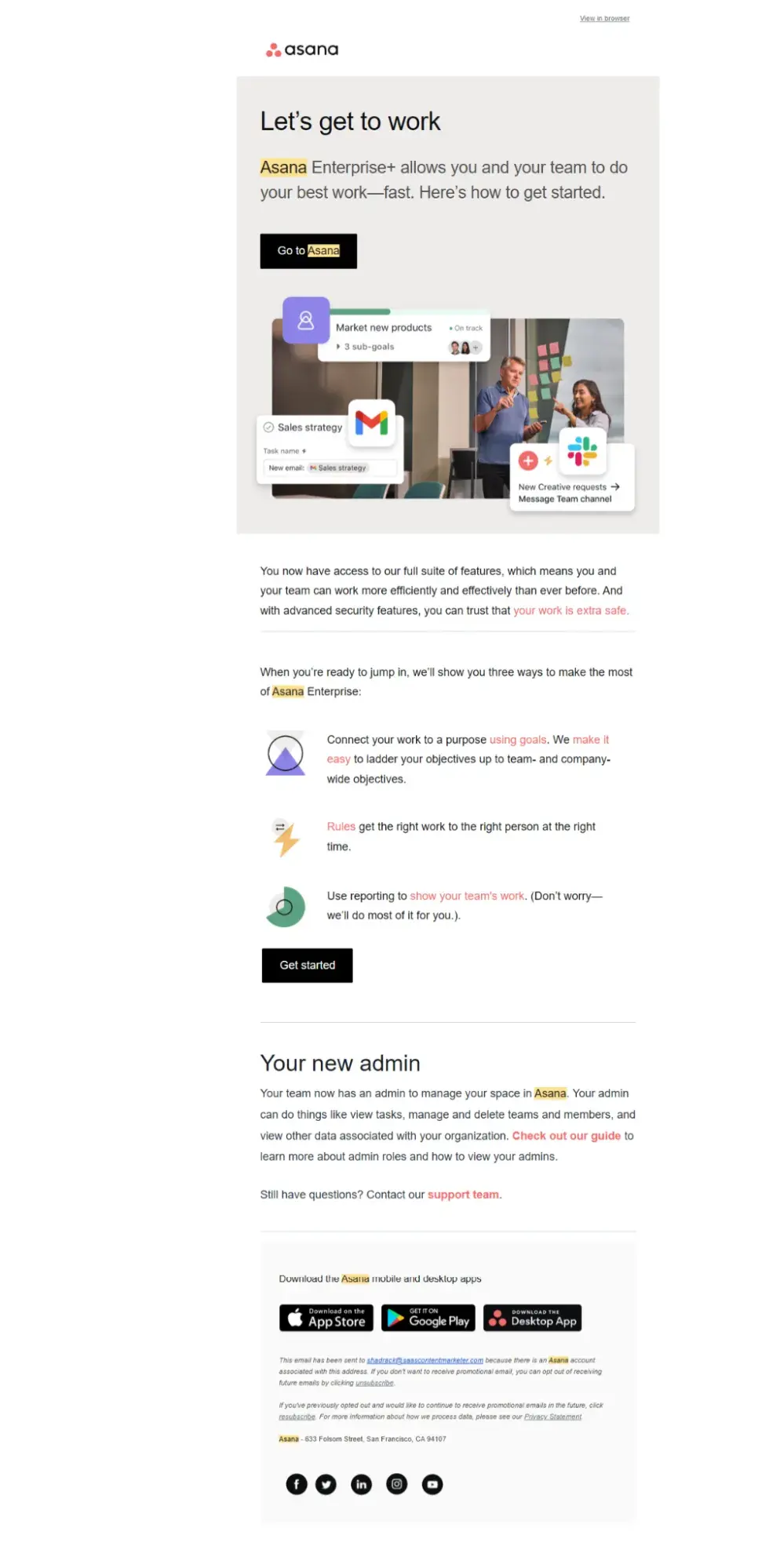
4. Write effective subject lines.
No opens, no results. It’s that simple. The key? Writing irresistible email subject lines.
Consider running A/B tests within your email automation software. A/B tests don’t just boost open rates. They reveal what language, tone, and topics connect with your audience. Test, analyze, and refine so you can consistently craft subject lines that drive higher open rates.
Preview how your subject lines look using a subject line tester, like CoSchedule’s Headline Analyzer, to spot length issues and improve readability before you hit send.
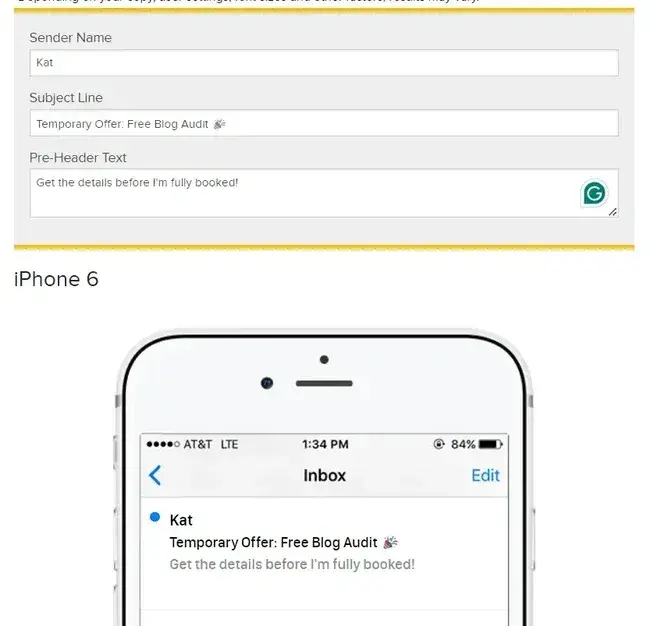
5. Include a CTA.
No matter the kind of email sequence you send out, you should always include a CTA to help your readers know what to do next if they decide to act. A clear CTA prevents confusion, drives action, and increases conversions — because without direction, most readers won’t act.
For example, if you’re sending out an abandoned cart email sequence, include a CTA such as “Continue shopping” or “Return to cart” to guide customers back to your website to complete the purchase.
If you don’t include this CTA, they'll close the email and forget about the cart completely.
So, before you hit send, ask yourself: Is my CTA clear, actionable, and easy to find? If not — fix it. If you’re unsure, test it: Could a reader act without reading anything else? If not, make it bolder, shorter, or more urgent.
6. Test all aspects of your email sequence.
Testing your subject line boosts open rates, but why stop there? Every element, from CTAs to design, can impact engagement, clicks, and conversions, so I believe it’s worth testing beyond the subject line. Test every aspect of your email sequence, including CTAs, design elements, email body copy, and the number of emails in a sequence.
Start with one variable at a time, such as testing two subject lines or different CTA placements, to identify what moves the needle.
For example, test subject lines over a week to gather statistically significant data or alternate CTA placements across two email campaigns to identify performance differences. Running split tests on these email elements will help you know which ones resonate most with your audience and encourage them to take action.
When you have this data, you’ll be able to increase open rates, boost click-throughs, and drive more conversions. With 38% of brands increasing their email budget, testing and optimizing your sequences isn’t optional. It’s how you stay competitive. Are your budget and testing strategy ready to keep up?
7. Personalize beyond their first name.
Make your emails feel like they’re written for the reader, not at them. True personalization goes beyond adding a name to the subject line. Tailor emails based on behavior, preferences, and purchase history because personalization isn’t just a tactic. It’s a trust-builder.
For example, you can send follow-ups based on clicks, downloads, or purchases to meet subscribers with exactly what they need when they need it. If someone downloaded a free guide on marathon training, follow up with a discount on running shoes or an invite to a virtual coaching session.
“Hey Jamie, still thinking about those running shoes? Lace up with 10% off — because your next mile is waiting.”
If you’re not using behavior-based triggers, you’re leaving money on the table. I’ve found even one personalized follow-up can drive conversions.
8. Build trust before, during, and after the sequence.
The relationship doesn’t end when the sequence does. Focus on clarity, consent, and follow-through — because trust is earned in every inbox interaction.
Trust me, nobody wants to hunt for the unsubscribe button or, worse, log into some forgotten account. And nothing kills trust faster than unsubscribing and still getting emails. (You know the ones: “You’ll stop receiving emails... in 7-10 business days.”) Why is it so hard to just leave?
Make unsubscribing human and easy. No guilt trips. No hoops. No delays.
Try this: “Not loving our emails? Tell us what you’d rather see or unsubscribe — no hard feelings.”
People come back to brands that let them leave without a fight. If you want to reduce your unsubscribe rate, let subscribers choose how often they hear from you.
Here’s what you can add to your next welcome email sequence:
“Get emails your way. Choose ‘weekly updates,’ ‘just the big news,’ or even ‘email-free vacations.’”
Let them stay on their terms. That’s how you build trust because trust isn’t what you say. It’s being considerate enough to respect their time and preferences.
From Theory to Practice: Implementing Your Email Strategy
Our journey started with a simple goal: Find a cost-effective way to grow without relying on referrals. What surprised me most was that it wasn’t just about earning $100,000 in 30 days.
It was discovering that the most powerful emails weren’t the ones with fancy designs or complex automation. They were the ones that felt human, celebrating others’ success before asking for anything in return.
Remember how we started with the ROI stats — email marketing’s 3600% return and automated workflows generating 320% more revenue?
Our experience proved these weren’t just numbers. But here’s what really matters: You don’t need a massive budget or complex tools to get started. Whether you’re a solo practitioner or running an agency, the same principles apply: lead with value, stay consistent, and make every email count.
Ready to write your own success story? Your next breakthrough might be just one sequence away.
Editor's note: This post was originally published in November 2015 and has been updated for comprehensiveness.
Sales Emails


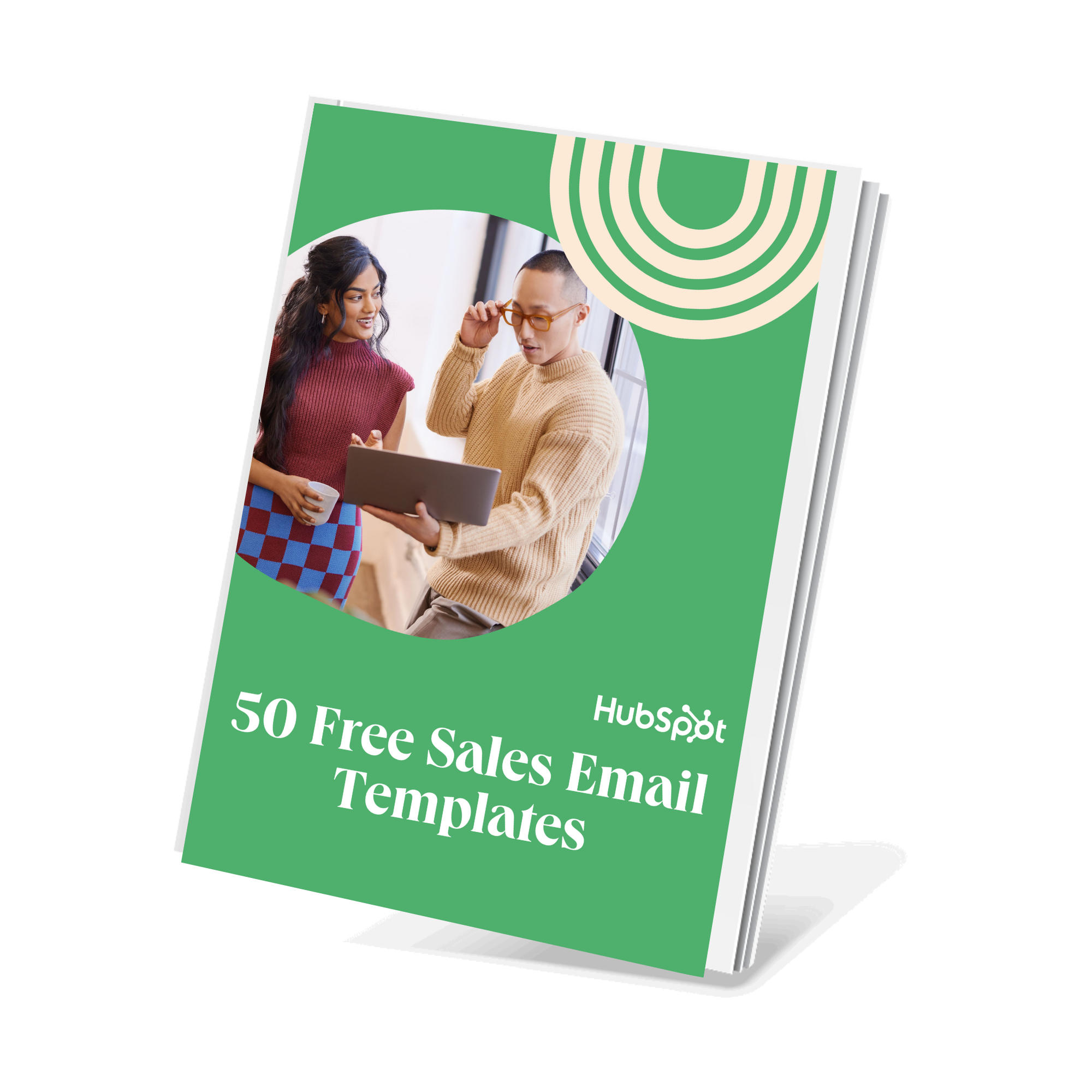
![Ghosted? How (and when) to send a follow-up email after no response [+ 18 examples]](https://53.fs1.hubspotusercontent-na1.net/hubfs/53/how-to-send-a-follow-up-email-after-no-response.jpg)
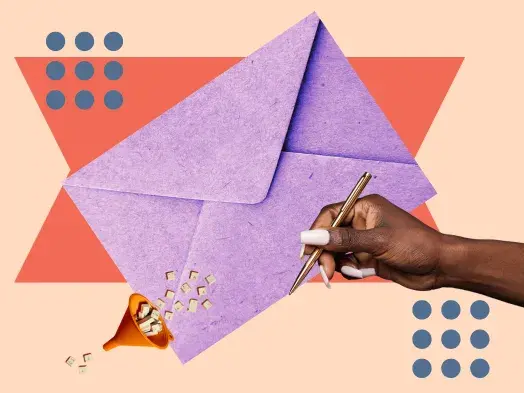
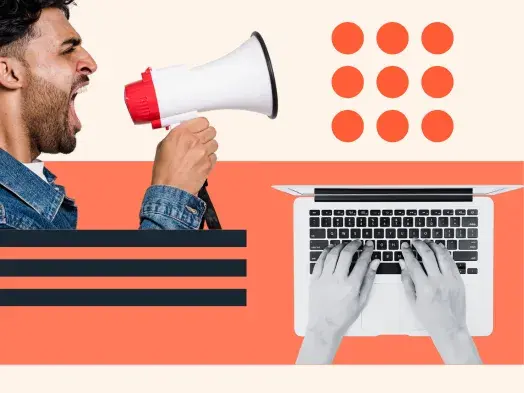
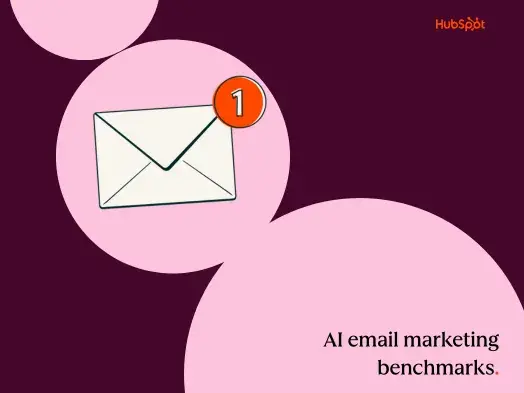
![23 Sales Email Templates With 60% or Higher Open Rates [+ Bonus Templates]](https://53.fs1.hubspotusercontent-na1.net/hubfs/53/sales-email-templates-2.jpg)

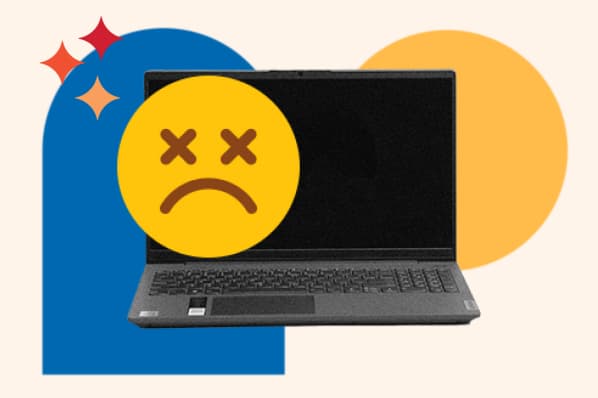
![How to Introduce Yourself in an Email in [Almost] Every Situation](https://53.fs1.hubspotusercontent-na1.net/hubfs/53/how-to-introduce-yourself-over-email-1.jpg)

